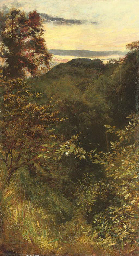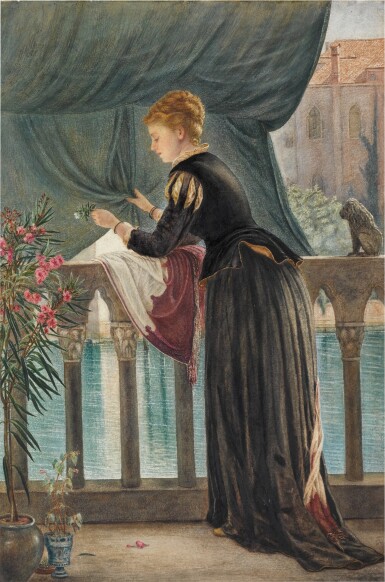GEORGE HOWARD, 9TH EARL OF CARLISLE (british 1843-1911) "THE FOUR SEASONS" Pencil and grey wash heightened with white and gold on paper Sheet size, each: 32 1/2 x 14 1/4 in. (82.6 x 36.2cm) provenance: Anonymous Sale. Sotheby's, Belgravia, sale of February 12, 1974, lot 42 (as "Frederic Shields"). Acquired directly from the above sale. Private Collection, London, United Kingdom. Christie's, London, sale of December 11, 2014, lot 20. Acquired directly from the above sale. Private Collection, New York, New York. NOTE: George Howard, the 9th Earl of Carlisle, was a British aristocrat and politician who challenged his father's expectations by insisting on becoming a painter. He studied in Italy with Giovanni Costa (1826-1903) before returning to London in 1865 to continue his training at the Kensington and Heatherley Schools of Art. Within the Pre-Raphaelites, he was especially close to Sir Edward Burne-Jones (1833-1898) whom he befriended in 1865. Soon, Howard would become one of the artist's closest confidents. A generous patron, he acquired a few early paintings by Burne-Jones and later commissioned major works for his numerous residences. In 1867, Howard asked the architect Philip Webb (1831-1915) to build a house in London, located at no. 1 Palace Green, in the Arts & Crafts style, on a street that was known as Millionaires' Row. Upon its completion in 1872, textile designer William Morris (1834-1896) was asked to furnish and decorate the house, while Burne-Jones was commissioned to paint a series of canvases in the dining room. This house, as well as the Howard Castle and the Naworth Castle (which he inherited from his uncle, and whose towers can be seen in the background of our present work, "Summer") became important artistic locale for celebrities such as Lewis Carroll (1832-1898) and Alfred Tennyson (1809-1892). Howard's connection with Burne-Jones and Webb provide an interesting source of inspiration for these highly decorative drawings. While Webb was working on the Green Dining Room (now Morris Room) at the South Kensington Museum (now Victoria and Albert Museum), Burne-Jones, who was truly a tutor to Howard, provided a design for the room's stained-glass windows. It is highly possible that Howard would have seen Burne-Jones' series of six watercolor studies relating to this design, known today as "The Garland." Indeed, the imagery of Howard's Four Seasons echoes this famous series, which show young women gathering flowers, an early expression of the Aesthetic Movement. Representing seasons as alluring women was a typical theme of the 1860s. It echoed the general philosophy of the time, in which narrative considerations tended to give way to qualities of mood and poetic sentiment. Abstract and evocative imagery such as seasons aimed at contrasting and criticizing the prosaic subjects with moralist inflection that the majority of English artists favored in the 1850s. By doing so, Howard lived by Théophile Gautier's (1811-1872) conclusion which he expressed in the preface to Mademoiselle de Maupin in 1834, dismissing the idea of a morality in artistic expression.
GEORGE HOWARD, 9TH EARL OF CARLISLE (british 1843-1911) "THE FOUR SEASONS" Pencil and grey wash heightened with white and gold on paper Sheet size, each: 32 1/2 x 14 1/4 in. (82.6 x 36.2cm) provenance: Anonymous Sale. Sotheby's, Belgravia, sale of February 12, 1974, lot 42 (as "Frederic Shields"). Acquired directly from the above sale. Private Collection, London, United Kingdom. Christie's, London, sale of December 11, 2014, lot 20. Acquired directly from the above sale. Private Collection, New York, New York. NOTE: George Howard, the 9th Earl of Carlisle, was a British aristocrat and politician who challenged his father's expectations by insisting on becoming a painter. He studied in Italy with Giovanni Costa (1826-1903) before returning to London in 1865 to continue his training at the Kensington and Heatherley Schools of Art. Within the Pre-Raphaelites, he was especially close to Sir Edward Burne-Jones (1833-1898) whom he befriended in 1865. Soon, Howard would become one of the artist's closest confidents. A generous patron, he acquired a few early paintings by Burne-Jones and later commissioned major works for his numerous residences. In 1867, Howard asked the architect Philip Webb (1831-1915) to build a house in London, located at no. 1 Palace Green, in the Arts & Crafts style, on a street that was known as Millionaires' Row. Upon its completion in 1872, textile designer William Morris (1834-1896) was asked to furnish and decorate the house, while Burne-Jones was commissioned to paint a series of canvases in the dining room. This house, as well as the Howard Castle and the Naworth Castle (which he inherited from his uncle, and whose towers can be seen in the background of our present work, "Summer") became important artistic locale for celebrities such as Lewis Carroll (1832-1898) and Alfred Tennyson (1809-1892). Howard's connection with Burne-Jones and Webb provide an interesting source of inspiration for these highly decorative drawings. While Webb was working on the Green Dining Room (now Morris Room) at the South Kensington Museum (now Victoria and Albert Museum), Burne-Jones, who was truly a tutor to Howard, provided a design for the room's stained-glass windows. It is highly possible that Howard would have seen Burne-Jones' series of six watercolor studies relating to this design, known today as "The Garland." Indeed, the imagery of Howard's Four Seasons echoes this famous series, which show young women gathering flowers, an early expression of the Aesthetic Movement. Representing seasons as alluring women was a typical theme of the 1860s. It echoed the general philosophy of the time, in which narrative considerations tended to give way to qualities of mood and poetic sentiment. Abstract and evocative imagery such as seasons aimed at contrasting and criticizing the prosaic subjects with moralist inflection that the majority of English artists favored in the 1850s. By doing so, Howard lived by Théophile Gautier's (1811-1872) conclusion which he expressed in the preface to Mademoiselle de Maupin in 1834, dismissing the idea of a morality in artistic expression.











.jpg)
.jpg)


Try LotSearch and its premium features for 7 days - without any costs!
Be notified automatically about new items in upcoming auctions.
Create an alert